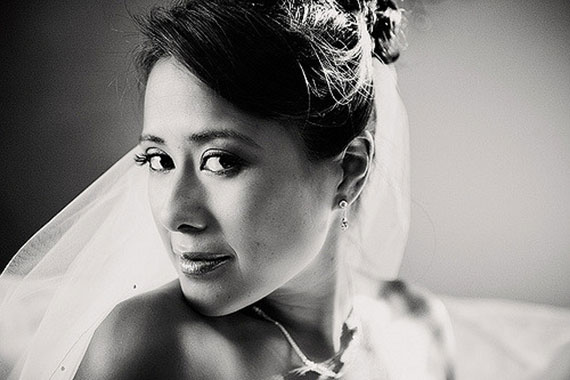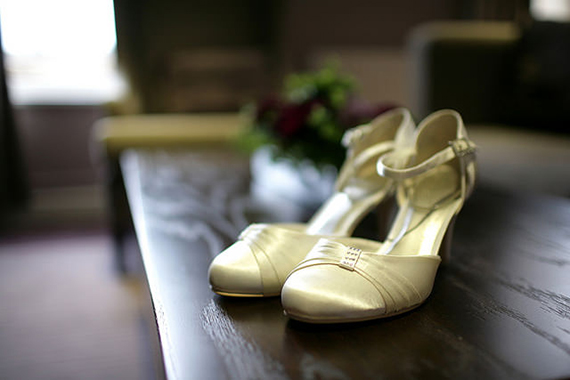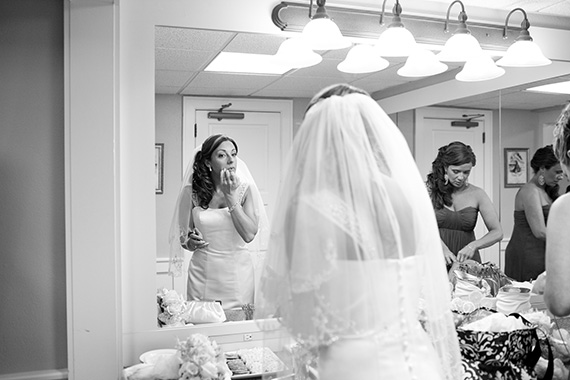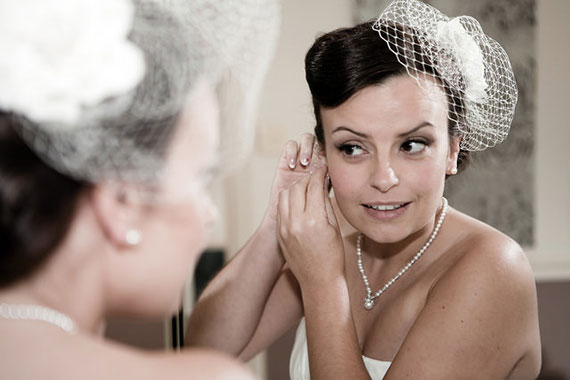I love this part of the story. As you arrive at wherever the bride is getting ready you never really know what’s is in store for you. If it’s at a house I knock on the door and wait, if a hotel I ask reception to ring up to see if they are ready for me but all the time wondering what mental state everyone is going to be in.

Photo by Deann Barrera
The most chilled bride at meetings might be in a mad panic over some detail or other. People might be running late and you are the last person they want to see. Or everyone might be so relaxed that it’s hard to get a sense of excitement or anticipation into shots. Whatever people are feeling, it’s the start of the story and really important to set the tone for the day ahead and get some good images in the bag straight away.
Sometimes I find it hard to get going. I like to get into a flow through the day and how I start seems to be crucial. On entering the room where the bridal party is getting ready I try to introduce myself to everyone and let them know the type of photographer I’m going to be throughout the day. “Just keep on doing what you are doing and for the most part ignore me. I’ll just lurk around and get a few shots. Oh, and chuck me out of the room if you need to change.” That sort of thing.
The first thing I do when entering a room is look at the light. Where is it coming from? How much of it is there? What is the quality of light like? (Is it a room full of horrible downlighters blazing away? Is there a window with lovely soft light streaming through?) This tells me where I need to be to get well lit images and what my background is going to look like.
I’m going to take a moment here to lay out my feeling on how much interference I allow myself as a photographer. I used to be a documentary fascist and never alter anything in a room or ask anyone to move to a better position or even into the light. I have mellowed. The photojournalistic or reportage approach is a style of photography to me and one I really enjoy, but I also have to serve my clients to the best of my ability. I now will tidy up a background by moving things out of the way, suggest that certain things happen in certain places (“Can you get into the dress over by this window?” “Stand here to help put the necklace on.”) and if timings are crucial for me to, say, get to a church even suggest when a bride gets into her dress so I can tell that part of the story as well as catch everyone arriving at the church.
I’m setting the stage for things to happen but not dictating what happens. The day still flows naturally but I can capture it in the best way possible within the setting.
Having said hello to everyone and looked at the light, the next thing I tend to do is get texture shots that are expected but also make a nice start to the story. Shoot the dress, the shoes, jewelry, flowers, personal good luck cards/tokens, anything special or personal to the day that is around. These can be uninspiring ‘weddingy’ things to shoot but I find if I do this first then it acts as a warm up for me to get my eye in and for people to be used to hearing the shutter going off and having me around. But I like to always be aware of what else is happening. I don’t want to be doing these shots if the make up artist is about to start on the bride or Mum pops in to see how everyone is and I miss a lovely moment. I’m flexible and alert and keep a mental checklist of everything I want to shoot in the room.
For those of a technical disposition, this is how I’m generally shooting this part of the day: 28mm f/1.8 on my 1D Mark IV, 85mm f/1.8 on my 5D Mark II both shooting in Aperture Priority at f/2. Lots of light flooding in with a nice shallow depth of field and hopefully a beautiful bokeh.
The way I work, there is a lot of waiting around. I’m not hurrying people to get things done or arriving after the fact and asking people to stage what has already happened, I like to be there when it does occur, hence the waiting. If I know I have loads of time to cover the preparations I’ll occasionally step out of the room to get some other texture shots. If at the bride’s/mother’s house then something personal to them that will mark this transition phase of the relationship (parental wedding photos with something apt reflected or good luck cards) or if it’s at the venue then I might take the opportunity to photograph the ceremony room/wedding breakfast details.

photo by Joe Hunt
There will always be things happening. Hair is teased, make up applied or checked, bridesmaids arrive, Mum arrives, flowers delivered. The list goes on and on but in a logical progression. Everything is building to getting the dress on and going to the ceremony.
Most of the time I’m standing and observing, waiting for those moments of activity that push the story forward, and then it’s a flurry of activity from me as I move around my subject getting the story from various angles and from close and wide. This is where I’m constantly aware of the light. I love to have a good amount of natural light coming from one direction and will ask that things take place in this light if it’s necessary to move people. (I used to be so hardcore as to not interfere at all but then I’d just be there cursing to myself that there was this beautiful light and no one was in it!) If the room is dual aspect and you have light flooding from two directions I have been known to ask if I can close one set of curtains to get some beautiful directional light rather than have a very overlit, flat scene. But mostly you are fighting for light rather than fighting an abundance of it.

photo by erratic creative
Preparation shots fall into a couple of categories for me: detail and scene-setting. I love to get the finer detail of what is going on: dresses being fastened, hair teased, make up applied, but also the situation in general. How busy is the room? Who is around? How many things are happening at the same time? What’s the scene that the bride will remember? Are there any moments when people walk in and see the bride for the first time? (When parents walk in and see their daughter for the first time on her wedding day, emotions run really high and there are only a few moments to capture this. I step back so as not to be part of it but capture the scene in a wide and with some close ups.)
I always arrange with my brides they are getting into the dress so I can get the details of this happening. Quite often it’s tense, joyful, difficult, exciting but never dull, and it creates a natural end to the preparation phase. If there is time after the dress is on I might see if I can take a quick portrait of the bride (in that nice directional light) as this is the freshest and most perfect she will look all day and it’s often an opportunity to get a nice portrait that you can show her in the back of the camera so she knows how fantastic she looks.

Photo by Adam Foster; ISO 200, f/2.8, 1/15-second exposure.
Next time I want to look at the groom and everything I might try to capture about him before the ceremony. (Normally you’ll find him in the bar).
About the Author:
Andrew Billington is a professional wedding photographer based in Staffordshire, England. “My approach to wedding photography is to create a natural, relaxed set of images telling the story of the day. I am passionate about good wedding photography and that it is the photographer’s job to create a very individual set of images of each wedding day. I live with Rachel, my wife, and shoot all over the UK.”
Like This Article?
Don't Miss The Next One!
Join over 100,000 photographers of all experience levels who receive our free photography tips and articles to stay current:






Very thoughtful and detailed. I love shooting preparation. Calm before the storm :)
Interesting…. any tips for the (slightly) older brides – like over 40 or 2nd half-century? and no longer “young and perky”
Extremely useful tutorial! I will print it and study it to check my preparations for an event! Thank you for you time to write this!
Weddings are events which are the most special to the bride and the groom. Brides especially plan for their dream wedding right from the time they are little girls. The only thing that can capture this day is photographs and your tips on wedding photographs will certainly make the day memorable to many.
Excellent wedding photography tips. Bridal preparation is so important moment of each wedding and so exciting.
I as wedding photographer really enjoy working with the brides and the bridesmaids during the preparation. So many things can go wrong so thank you for the good list of tips to follow. The preparation moments are so precious that I recommend to all brides to consider allowing the photographer to participate and capture them. Absolutely agree that candid and non obtrusive approach is the best. This was everyone is relaxed and playful instead of trying to pose and arrange the moments.
The wedding photographer is merely an observer and there to document. Push too much and the whole magic is gone. Thank you for the great resource. Hope many brides would read and follow these simple steps.
Great article- and so true about finding the groom at the bar. :) Nice insight for brides to enjoy.